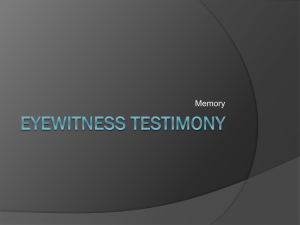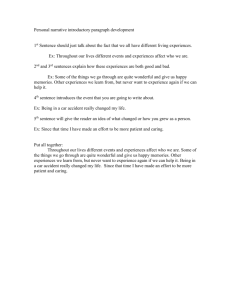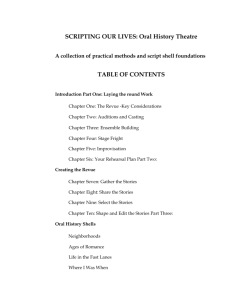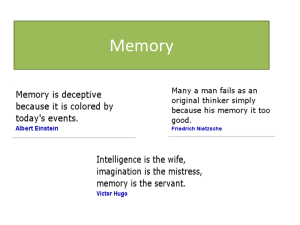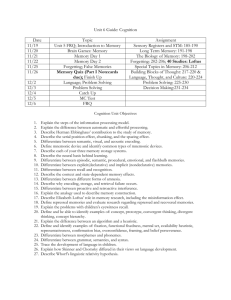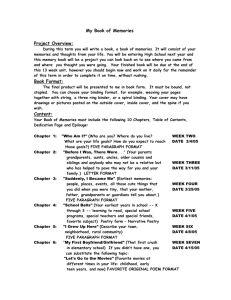Make-Believe Memories - HomePage Server for UT Psychology
advertisement
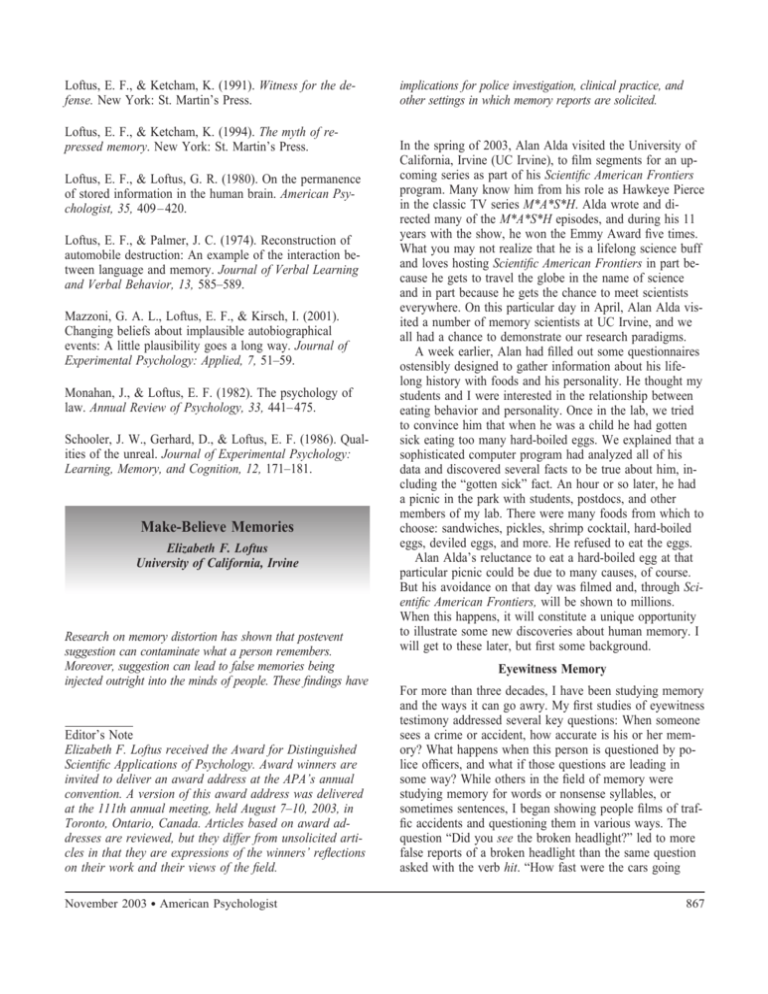
Loftus, E. F., & Ketcham, K. (1991). Witness for the defense. New York: St. Martin’s Press. Loftus, E. F., & Ketcham, K. (1994). The myth of repressed memory. New York: St. Martin’s Press. Loftus, E. F., & Loftus, G. R. (1980). On the permanence of stored information in the human brain. American Psychologist, 35, 409 – 420. Loftus, E. F., & Palmer, J. C. (1974). Reconstruction of automobile destruction: An example of the interaction between language and memory. Journal of Verbal Learning and Verbal Behavior, 13, 585–589. Mazzoni, G. A. L., Loftus, E. F., & Kirsch, I. (2001). Changing beliefs about implausible autobiographical events: A little plausibility goes a long way. Journal of Experimental Psychology: Applied, 7, 51–59. Monahan, J., & Loftus, E. F. (1982). The psychology of law. Annual Review of Psychology, 33, 441– 475. Schooler, J. W., Gerhard, D., & Loftus, E. F. (1986). Qualities of the unreal. Journal of Experimental Psychology: Learning, Memory, and Cognition, 12, 171–181. Make-Believe Memories Elizabeth F. Loftus University of California, Irvine Research on memory distortion has shown that postevent suggestion can contaminate what a person remembers. Moreover, suggestion can lead to false memories being injected outright into the minds of people. These findings have Editor’s Note Elizabeth F. Loftus received the Award for Distinguished Scientific Applications of Psychology. Award winners are invited to deliver an award address at the APA’s annual convention. A version of this award address was delivered at the 111th annual meeting, held August 7–10, 2003, in Toronto, Ontario, Canada. Articles based on award addresses are reviewed, but they differ from unsolicited articles in that they are expressions of the winners’ reflections on their work and their views of the field. November 2003 ● American Psychologist implications for police investigation, clinical practice, and other settings in which memory reports are solicited. In the spring of 2003, Alan Alda visited the University of California, Irvine (UC Irvine), to film segments for an upcoming series as part of his Scientific American Frontiers program. Many know him from his role as Hawkeye Pierce in the classic TV series M*A*S*H. Alda wrote and directed many of the M*A*S*H episodes, and during his 11 years with the show, he won the Emmy Award five times. What you may not realize that he is a lifelong science buff and loves hosting Scientific American Frontiers in part because he gets to travel the globe in the name of science and in part because he gets the chance to meet scientists everywhere. On this particular day in April, Alan Alda visited a number of memory scientists at UC Irvine, and we all had a chance to demonstrate our research paradigms. A week earlier, Alan had filled out some questionnaires ostensibly designed to gather information about his lifelong history with foods and his personality. He thought my students and I were interested in the relationship between eating behavior and personality. Once in the lab, we tried to convince him that when he was a child he had gotten sick eating too many hard-boiled eggs. We explained that a sophisticated computer program had analyzed all of his data and discovered several facts to be true about him, including the “gotten sick” fact. An hour or so later, he had a picnic in the park with students, postdocs, and other members of my lab. There were many foods from which to choose: sandwiches, pickles, shrimp cocktail, hard-boiled eggs, deviled eggs, and more. He refused to eat the eggs. Alan Alda’s reluctance to eat a hard-boiled egg at that particular picnic could be due to many causes, of course. But his avoidance on that day was filmed and, through Scientific American Frontiers, will be shown to millions. When this happens, it will constitute a unique opportunity to illustrate some new discoveries about human memory. I will get to these later, but first some background. Eyewitness Memory For more than three decades, I have been studying memory and the ways it can go awry. My first studies of eyewitness testimony addressed several key questions: When someone sees a crime or accident, how accurate is his or her memory? What happens when this person is questioned by police officers, and what if those questions are leading in some way? While others in the field of memory were studying memory for words or nonsense syllables, or sometimes sentences, I began showing people films of traffic accidents and questioning them in various ways. The question “Did you see the broken headlight?” led to more false reports of a broken headlight than the same question asked with the verb hit. “How fast were the cars going 867 when they smashed into each other?” led to higher estimates of speed than a more neutral question that used the verb hit. Moreover, the “smashed” question led more people to later falsely claim that they had seen broken glass when there was none. My early papers concluded that leading questions could contaminate or distort a witness’s memory (see Loftus, 1979/1996, for a summary of this early research). In fact, leading questions are only one way to distort memory. Related studies showed that memory could become skewed with various techniques that fed misinformation to unsuspecting individuals. The studies used a simple procedure. Participants first see a complex event, such as a simulated automobile accident. Next, half of the participants receive misleading information about the accident, whereas the other half receive no misinformation. Finally, all of the participants try to remember the original accident. In one actual study using this paradigm, participants saw an accident, and later some of them received misinformation about the traffic sign used to control the intersection. The misled participants got the false suggestion that the stop sign that they had actually seen was a yield sign. When asked later what kind of traffic sign they personally remembered seeing at the intersection, those who had been given the false suggestion tended to adopt it as their memory and now claimed that they had seen a yield sign. Those who had not received the phony information had much more accurate memories. Today, hundreds of studies have been published documenting memory distortion induced by exposure to misinformation. In these studies, not only have people recalled stop signs as yield signs but they have also recalled nonexistent broken glass and tape recorders, a blue vehicle used in a crime scene as white, Minnie Mouse when they really saw Mickey Mouse, and, most recently, wounded animals (that were not there) near the scene of a tragic terrorist bombing that actually had occurred in Russia a few years earlier (Nourkova, Bernstein, & Loftus, 2003). Taken together, these studies show that misinformation can change an individual’s recollection in predictable, and sometimes very powerful, ways. Misinformation can influence people’s memories when they are interrogated in a suggestive fashion or when they talk to other people who give their version of the events. Misinformation can sway people when they see biased media coverage about some event that they may have experienced themselves. This phenomenon would ultimately be called the misinformation effect (Loftus & Hoffman, 1989). It might be tempting to suggest that memory distortion observed in the safety and pallid world of a laboratory setting would not generalize to the outside world or real events (as Yuille & Cutshall, 1986, have suggested). Indeed there are differences in the active/passive role, in the opportunity to observe, in the degree of emotional arousal, 868 and more. To explore this issue, a Norwegian research group recently exposed participants to a “live” crime and compared their memory performance with those who watched a video of the same crime (Ihlebaek, Love, Eilertsen, & Magnussen, 2003). The “live” group were participants in a course designed to teach them to cope with dangerous and violent armed-robbery situations and to cope with the psychological effects of experiencing such traumas. Robberies were staged, and participants experienced them live. Videotapes of those same robberies were shown to comparable participants. The results showed that participants who watched the videos reported more details and with higher accuracy than those who saw the live events, suggesting that laboratory experiments may actually overestimate memory performance. After more than two decades exploring the misinformation effect, many psychological scientists have contributed to the knowledge, and collectively we have learned a great deal about the conditions of its power. One group showed that postevent information can even affect the memories of three-month-old infants (Rovee-Collier, Borza, Adler, & Boller, 1993). Another group showed that one can even get the misinformation effect with pigeons (Harper & Garry, 2000). Fortunately, we have also learned that warning people about misinformation effects can sometimes enable them to successfully resist those effects (Highhouse & Bottrill, 1995). Many highly sophisticated models have been developed that specify when memory impairments will and will not be expected (Metcalfe, 1990). The misinformation research tradition continues today. For example, one group showed that people who thought they were drinking alcohol, but actually drank plain tonic water, were more swayed by misinformation than those who were not under the influence of an alcohol placebo (Assefi & Garry, 2002). Another research group recently examined the relative suggestive power of misinformation versus hypnosis (Scoboria, Mazzoni, Kirsch, & Milling, 2002). Participants heard a story and were later asked either neutral or misleading questions, either in or out of hypnosis. When tested later, the use of hypnosis increased memory errors, but the misleading questions produced even more errors. Moreover, the combination of the two (hypnosis and misleading questions) produced more errors than either method by itself. The particular kind of error made by those who were asked misleading questions was to shift from reporting not knowing an answer to questions to reporting false information about the past. From this example, it becomes evident that researchers are learning a great deal about the precise way in which misinformation has immediate and persisting deleterious effects on memory. That misleading questions might have more pernicious effects than prior exposure to hypnosis led Scoboria et al. (2002) to question existing legal practices concerning the November 2003 ● American Psychologist circumstances under which witness testimony is admitted or excluded in court cases. Planting False Memories It is one thing to change a stop sign into a yield sign, to turn Mickey into Minnie, or to add a detail to a memory report for something that actually did happen. But could one create an entire memory for an event that never happened? My first attempt to do this used a procedure whereby participants were given short narrative descriptions of childhood events and encouraged to try to remember those events. While participants believed that all of the descriptions were true and had been provided by family members, one was actually a pseudoevent that had not occurred. In this study, approximately 25% of participants were led to believe, wholly or partially, that at age 5 or 6 they had been lost in a shopping mall for an extended time, were highly upset, and were ultimately rescued by an elderly person and reunited with their family (Loftus & Pickrell, 1995). Many added embellishing details to their accounts. The method of using family members to help plant false memories has been dubbed the familial informant falsenarrative procedure (Lindsay, Hagen, Read, Wade, & Garry, in press), but it is probably easier to call it simply the lost-in-the-mall technique. Many investigators have used the lost-in-the-mall technique to plant false memories of events that would have been far more unusual, bizarre, painful, or even traumatic had they actually occurred. Participants have been led to believe that they had been hospitalized overnight or that they had an accident at a family wedding (Hyman, Husband, & Billings, 1995; Hyman & Pentland, 1996). They have been convinced that they had nearly drowned and had to be rescued by a lifeguard (Heaps & Nash, 2001). They have fallen sway to the suggestion that they were once the victims of a vicious animal attack (Porter, Yuille, & Lehman, 1999). Most studies find that a significant minority of participants will develop partial or complete false memories. In a set of studies reviewed by Lindsay et al. (in press), the average falsememory rate was 31%, but in individual studies, of course, the figures can vary. Sometimes people have been resistant to suggestions, as they were when investigators tried to plant false memories of having received a rectal enema (Pezdek, Finger, & Hodge, 1997). Conversely, sometimes false memories have been planted in the minds of more than 50% of exposed individuals, as they were when investigators tried to plant false memories of having gone up in a hot-air balloon ride (Wade, Garry, Read, & Lindsay, 2002). Particularly striking are the complete false memories, or what might be termed rich false memories, which are experiences about which a person can feel confident, provide details, even express emotion about made-up events that never happened (Loftus & Bernstein, in press). November 2003 ● American Psychologist Rich False Memories One interpretative issue that recurs in this memory distortion research is whether we are truly planting a false memory. Perhaps the suggestive manipulation is leading people to discover a true memory rather than leading them to embrace a false one. To investigate this issue, researchers have adopted several methods, including one that attempts to create a false memory for a recent event (e.g., “What you did on a particular day?”). If you as a researcher know precisely what happened that day and you lead the participant to “remember” doing something else, you have fairly good evidence that you have created a false report. This strategy was first adopted by Goff and Roediger (1998) and later modified by my colleague and me (Thomas & Loftus, 2002). In one study, participants sat in front of a large table filled with numerous objects. They heard a series of statements (e.g., “flip the coin”) and then had to perform or imagine performing the called-for actions. The next time they came to the lab, there were no objects in front of them, but they simply imagined that they performed various actions. In a final session, their memory for what they did that first day was tested. After a few imaginations, participants occasionally remembered performing actions that they had not performed. They falsely claimed that they did things that would have been common (e.g., roll the dice), but they also claimed that they did things that would have been rather bizarre or unusual, such as “rub the chalk on your head” or “kiss a plastic frog” (Thomas, Bulevich, & Loftus, in press; Thomas & Loftus, 2002). Imagination can not only make people believe they have done simple things that they have not done but can also lead people to believe that they have experienced more complex events. In one study, participants watched a video clip of a drunk-driving incident. Later, some participants imagined a scene that was not part of the presented scenario. They imagined seeing a policeman stop the car and ask the driver to step out but the driver refuse. Later, 15% of “imagine” participants mentioned seeing the false details when tested with free recall, and an astonishing 41% claimed to have seen these false details when tested with recognition-type memory items (Wright, Loftus, & Hall, 2001). Another method for assessing whether the suggestive manipulations are planting false memories is to try to plant memories for things that would be implausible or even impossible. For instance, it has been possible to plant beliefs or false memories of witnessing demonic possession as a child (Mazzoni, Loftus, & Kirsch, 2001). And it has been even easier to plant a false memory of meeting Bugs Bunny at a Disney Resort (Braun, Ellis, & Loftus, 2002). The latter was accomplished by presenting participants with fake ads for Disney that featured Bugs Bunny. In one study, exposure to the fake ad led 16% of participants to later claim that they had personally met Bugs at 869 Disneyland. This could not have occurred because Bugs Bunny is a Warner Brothers character and would not be found at Disneyland. This impossibility was far more colorfully put by Andrew Malcolm in his unsigned (voice of the paper) editorial in the Los Angeles Times: “the wascally Warner Bros. Wabbit would be awwested on sight” at Disney (“You Must Remember This,” 2003, p. 10). Follow-up studies showed that even more individuals (25% in one study; 36% in another) fell sway to the suggestion about meeting Bugs after multiple exposures to fake ads featuring Bugs Bunny (Grinley, 2002). What do people remember about their encounter with this character whom they could not have met? Of those recalling a personal encounter with Bugs, 62% said they shook his hand, and 46% remembered hugging him. Others remembered touching his ear or tail, or even hearing him speak (“What’s up, Doc?”). These false memories, thus, were imbued with sensory detail, just the kind of sensory detail that people use as a cue to decide whether a memory is true or false. Alan Alda looked at our fake ads for Disney. He closely examined the one featuring Bugs and compared it with our generic ad for Disney that did not mention the cartoon character. He explained that he preferred the generic ad, mostly because of its colors. Later, while picnicking in the park, he was asked about his own childhood trip to Disney and which characters he met there. When asked specifically about Bugs Bunny, he said, “No way, he’s a Warner Brothers character.” Thus, he resisted the suggestion in the fake ad, as did most of our real experimental participants. But, as I explain later, his resistance did not appear to be operating when it came to the hard-boiled egg. False Memories Matter True memories seem to have consequences for people. If you remember that someone insulted you in the past, you might avoid encounters with that unpleasant individual in the future. But what if you had a false memory of being insulted? Would you similarly avoid that person later? It seems like this would be the case, but virtually all of the false-memory research stops when the affected individual accepts the scenario. Occasionally, there have been efforts to find out if the person has merely a belief that the event happened with no accompanying feelings of recollection. Sometimes that is all there is to the experience, simply a false belief. But sometimes the person has the subjective sense of recollection, replete with sensory details. It is this experience that is more akin to what has been called a rich false memory. In the typical study, debriefing of participants occurs after probing for a memory report, and the study is soon over. Now, what if debriefing could be delayed so that one could see whether the false memory affects the thoughts or behaviors of the person down the road? One might then be able to show that false memories have consequences, that they do matter. 870 Another way to think about this issue is to realize that suggestions can render an individual willing to make a new, possibly false memory report. This has been amply demonstrated. But are there memory correlates? Are there other mental processes or behaviors that also are affected in the process of exposure to suggestive influences? If so, one might be seeing an even deeper effect of those influences. This was the rationale behind one study designed to see if planting the suggestion about meeting Bugs Bunny at Disney would affect the recipient’s thought processes (Grinley, 2002). In this study, participants were first convinced that they had met Bugs Bunny at a Disney resort. Later, they were given a new test: They saw the names of pairs of cartoon characters, such as Mickey Mouse and Donald Duck, and had to indicate how related the characters were to one another. Some pairs were highly related, like Mickey and Minnie Mouse. Some pairs were not particularly related, like Donald Duck and Sleeping Beauty. After being exposed to the fake Disney ads featuring Bugs Bunny, people rated the pair Mickey Mouse and Bugs Bunny to be more closely related. For a time, then, the thought processes or semantic structures of ad-exposed individuals were influenced. A further investigation of the consequences of false beliefs or memories involves a recent ongoing collaboration with postdoctoral fellow Daniel Bernstein and two graduate students, Cara Laney and Erin Morris. We induced participants to believe that when they were children they got sick eating hard-boiled eggs (or, for other participants, that they got sick eating dill pickles). We accomplished this mental feat by gathering data from the participants and plying them with false feedback. We told them that a sophisticated computer program had analyzed their data and determined that they had had one of these “sick” experiences as a child. We found that those given the “dill pickle” feedback became more confident that they had had the experience as a child and those given the “hard-boiled egg” feedback became more confident of that experience. But would the increase in belief translate into subsequent behavior change? Would they, for example, avoid these foods when given the opportunity to eat them? To find out, we gave participants a “Party Behavior” questionnaire. They imagined themselves at a large barbeque and had to indicate which foods they would like to eat. Those who were seduced by the dill pickle feedback reported being less likely to want to eat pickles, whereas those who fell for the egg feedback reported being less likely to want to eat eggs. When we demonstrated our methodology for Alan Alda during his visit to UC Irvine, he showed increased confidence that he had gotten sick eating hard-boiled eggs as a child. When later offered hard-boiled eggs and deviled eggs at a picnic in the park, Alda declined to eat them. Our November 2003 ● American Psychologist findings in the “food” study constitute the beginning of a method for studying false memories and their consequences. But they also hint at unexpected applications: what a potentially easy way to make people avoid certain foods. In The Tragedy of King Richard the Second, Shakespeare asked a simple question: “Who can . . . cloy the hungry edge of appetite by bare imagination of a feast?” We cannot do this, he suggested, any more than we can easily walk “naked in December snow by thinking on fantastic summer’s heat.” Thinking about the good, Shakespeare noted, makes us feel worse. Our results would give Shakespeare food for thought (excuse the pun). It is not a feast that one should imagine but getting sick on that feast. More generally, our results are showing that changing a belief or memory can have important consequences for subsequent thoughts or behaviors. When you change memory, it changes you. True Versus False Memories In the ideal world, people would have a means of distinguishing true and false memories. Statistically, one occasionally can do this. In an effort to plant false memories of being lost in a shopping mall, we showed that true memories were held with more confidence than the false ones (Loftus & Pickrell, 1995). Other researchers have also found group differences. Wade et al. (2002), who planted false memories of taking a hot-air balloon ride as a child by showing participants doctored photographs, also showed that the true events they asked about were recalled with greater confidence than the false one. Porter et al. (1999), who planted false memories of being victimized by a serious animal attack as a child, found that the planted memories were rated as less coherent than real memories. There have also been promising efforts to use neurophysiological measures to distinguish true and false memories. Some differences have been reported using human lateralized brain potentials (Fabiana, Stadler, & Wessels, 2000), using the P300 component of event-related potentials (Miller, Baratta, Wynveen, & Rosenfeld, 2000), and using neuroimaging techniques (Schacter, Buckner, Koutstaal, Dale, & Rosen, 1997). By necessity, these studies have been done with true and false memories of words heard in a word list rather than with the eyewitness details or rich false memories. While promising, these preliminary efforts are still a long way from allowing researchers to take one individual memory and reliably classify it as being true or false. Theoretical and Practical Implications Collectively, researchers have learned a great deal about how false memories develop and are almost at the point of being able to write a recipe. First, the individual gets convinced that the false event is plausible. Even events that November 2003 ● American Psychologist start out being rather implausible can be made to seem more plausible by simple suggestion. Next, the individual gets convinced that the false event was personally experienced. Plying the person with false feedback is a particularly effective way to accomplish this. At this point, the individual might merely believe that the event is true but have no sense of recollection. But with guided imagination, with visualization of the stories of others, and with suggestive feedback and other sorts of manipulations, a rich false memory can develop. The research on false beliefs and memories has enormous relevance to everyday life. Analyses of the growing number of wrongful convictions, proven wrong by DNA evidence, have taught us that faulty eyewitness memory is the major cause (Technical Working Group for Eyewitness Evidence, 1999). This revelation has led to numerous recommendations for the legal system to protect the fact-finding process from the tragedies of mistaken memory, both in the United States and Canada (Yarmey, 2003). Analyses of the hundreds of case in which patients were led to believe falsely that they were molested for years in satanic rituals or that they were abducted by aliens and taken up in spaceships have taught us that suggestion is a key factor leading to these beliefs (McNally, 2003). Moreover, once they take hold, these “memories” can be expressed with great confidence, detail, and emotion. In one study, individuals who believed they had been abducted by aliens were as emotionally aroused by thinking of their terrifying abductions as they were about other stressful experiences, or as “nonabducted” individuals were when they recalled personal traumas (McNally, 2003). Two take-home lessons flow from this research: (a) Suggestion can lead to rich false memories, and (b) just because a memory report is expressed with confidence, detail, and emotion does not necessarily mean the underlying event actually happened. McNally (2003) expressed his faith in the value of cognitive psychology to help resolve some of the controversies in this area. It is with the methods of cognitive psychology, he argued, that scientists will be able to test their hypotheses not only about how people may forget traumatic events but also about how people “come to believe they have been traumatized when, in fact, they have not” (McNally, 2003, p. 274). My efforts to write about the power of suggestion to create false memories have been with the hope of encouraging changes in procedures and practices (Loftus, 2002, 2003; Loftus & Ketcham, 1991, 1994). Aggressive efforts to unearth presumably recalcitrant trauma memories can lead to false-memory reports. Uncritical acceptance of every trauma memory report can harm the false victims and, also sadly, trivialize the experiences of the true victims. Outside the world of litigation or psychotherapy, the findings about memory distortion have implications for ordinary life. Take the reading of autobiographies and 871 memoirs. The pioneering physicist Edward Teller recently wrote one (Teller, 2001) and was resoundingly criticized for his “notorious” selective memory, and specifically for “vividly remembering events that never happened.” A more charitable analysis of Teller’s work might involve appreciating it not as a deliberately self-serving untruthful chronicle but for its possible insights into normal memory-distortion processes. Untruths are not necessarily lies. As for the “memoir” of Binjamin Wilkomirski in Fragments—the false account of a small child’s ordeal in the Holocaust— was it a deliberate lie, or did he somehow come to convince himself it was true? (See Eskin, 2002.) A different area of psychological science is needed to distinguish the deliberate lie from the “honest” lie. But sometimes what starts as a deliberate lie becomes the person’s “truth.” The story creates a memory rather than the other way around. It has been said that we are sum of our memories, that all that we have ever experienced goes into that end product. But after three decades of my research on memory in general and memory distortion in particular, it makes sense to consider the reverse of this statement. People’s memories are not only the sum of all that they have done, but there is more to them: The memories are also the sum of what they have thought, what they have been told, what they believe. Who we are may be shaped by our memories, but our memories are shaped by who we are and what we have been led to believe. Or as the psychiatrist Sally Satel (2003) said, “We are always angling the prism of memory” (p. 31). We seem to reinvent our memories, and in doing so, we become the person of our own imagination. Author’s Note Correspondence concerning this article should be addressed to Elizabeth F. Loftus, Department of Psychology and Social Behavior and Department of Criminology, Law and Society, University of California, Irvine, CA 926977085. E-mail: eloftus@uci.edu References Assefi, S. L., & Garry, M. (2002). Absolut memory distortions: Alcohol placebos influence the misinformation effect. Psychological Science, 14, 77– 80. human lateralized brain potentials. Journal of Cognitive Neuroscience, 12, 941–949. Goff, L. M., & Roediger, H. L., III. (1998). Imagination inflation for action events: Repeated imaginings lead to illusory recollections. Memory & Cognition, 26, 20 –33. Grinley, M. J. (2002). Effects of advertising on semantic and episodic memory. Unpublished master’s thesis, University of Washington. Harper, D. N., & Garry, M. (2000). Postevent cues bias recognition performance in pigeons. Animal Learning and Behavior, 28, 59 – 67. Heaps, C. M., & Nash, M. (2001). Comparing recollective experience in true and false autobiographical memories. Journal of Experimental Psychology: Learning, Memory, and Cognition, 27, 920 –930. Highhouse, S., & Bottrill, K. V. (1995). The influence of social (mis)information on memory for behavior in an employment interview. Organizational Behavior and Human Decision Processes, 62, 200 –229. Hyman, I. E., Jr., Husband, T. H., & Billings, F. J. (1995). False memories of childhood experiences. Applied Cognitive Psychology, 9, 181–197. Hyman, I. E., Jr., & Pentland, J. (1996). The role of mental imagery in the creation of false childhood memories. Journal of Memory and Language, 35, 101–117. Ihlebaek, C., Love, T., Eilertsen, D. E., & Magnussen, S. (2003). Memory for a staged criminal event witnessed live and on video. Memory, 11, 319 –327. Lindsay, D. S., Hagen, L., Read, J. D., Wade, K. A., & Garry, M. (in press). True photographs and false memories. Psychological Science. Loftus, E. F. (1996). Eyewitness testimony. Cambridge, MA: Harvard University Press. (Original work published 1979) Braun, K. A., Ellis, R., & Loftus, E. F. (2002). Make my memory: How advertising can change our memories of the past. Psychology and Marketing, 19, 1–23. Loftus, E. F. (2002). Memory faults and fixes. Issues in Science and Technology, 18(4), 41–50. Eskin, B. (2002). A life in pieces: The making and unmaking of Binjamin Wilkomirski. New York: Norton. Loftus, E. F. (2003). Our changeable memories: Legal and practical implications. Nature Reviews: Neuroscience, 4, 231–234. Fabiana, M., Stadler, M. A., & Wessels, P. M. (2000). True but not false memories produce a sensory signature in Loftus, E. F., & Bernstein, D. M. (in press). Rich false memories: The royal road to success. In A. Healy (Ed.), 872 November 2003 ● American Psychologist Experimental cognitive psychology and its applications: Festschrift in honor of Lyle Bourne, Walter Kintsch, and Thomas Landauer. Washington DC: American Psychological Association. Loftus, E. F., & Hoffman, H. G. (1989). Misinformation and memory: The creation of memory. Journal of Experimental Psychology: General, 118, 100 –104. Loftus, E. F., & Ketcham, K. (1991). Witness for the defense. New York: St. Martin’s Press Loftus, E. F., & Ketcham, K. (1994). The myth of repressed memory. New York: St. Martin’s Press. Loftus, E. F., & Pickrell, J. E. (1995). The formation of false memories. Psychiatric Annals, 25, 720 –725. Satel, S. (2003, May 19). The trauma society. New Republic, 228, 29 –36. Schacter, D. L., Buckner, R. L., Koutstaal, W., Dale, A. M., & Rosen, B. R. (1997). Late onset of anterior prefrontal activity during true and false recognition: An eventrelated fMRI study. Neuroimage, 6, 259 –269. Scoboria, A., Mazzoni, G., Kirsch, I., & Milling, L. S. (2002). Immediate and persisting effects of misleading questions and hypnosis on memory reports. Journal of Experimental Psychology: Applied, 8, 26 –32. Technical Working Group for Eyewitness Evidence. (1999). Eyewitness evidence: A guide for law enforcement. Washington, DC: U.S. Department of Justice, Office of Justice Programs. Mazzoni, G. A. L., Loftus, E. F., & Kirsch, I. (2001). Changing beliefs about implausible autobiographical events: A little plausibility goes a long way. Journal of Experimental Psychology: Applied, 7, 51–59. Teller, E. (with Schoolery, J.). (2001). Memoirs: A 20th century journey in science and politics. Cambridge, MA: Perseus. McNally, R. J. (2003). Remembering trauma. Cambridge, MA: Harvard University Press. Thomas, A. K., Bulevich, J. B., & Loftus, E. F. (in press). Exploring the role of repetition and sensory elaboration in the imagination inflation effect. Memory & Cognition. Metcalfe, J. (1990). Composite holographic associative recall model (CHARM) and blended memories in eyewitness testimony. Journal of Experimental Psychology: General, 119, 145–160. Miller, A. R., Baratta, C., Wynveen, C., & Rosenfeld, J. P. (2001). P300 latency, but not amplitude or topography, distinguishes between true and false recognition. Journal of Experimental Psychology: Learning, Memory, and Cognition, 27, 354 –361. Nourkova, V., Bernstein, D. M., & Loftus, E. F. (2003). Altering traumatic memory. Manuscript submitted for publication. Pezdek, K., Finger, K., & Hodge, D. (1997). Planting false childhood memories: The role of event plausibility. Psychological Science, 8, 437– 441. Porter, S., Yuille, J. C., & Lehman, D. R. (1999). The nature of real, implanted, and fabricated memories for emotional childhood events: Implications for the recovered memory debate. Law and Human Behavior, 23, 517–537. Rovee-Collier, C., Borza, M. A., Adler, S. A., & Boller, K. (1993). Infants’ eyewitness testimony: Effects of postevent information on a prior memory representation. Memory & Cognition, 21, 267–279. November 2003 ● American Psychologist Thomas, A. K., & Loftus, E. F. (2002). Creating bizarre false memories through imagination, Memory & Cognition, 30, 423– 431. Wade, K. A., Garry, M., Read, J. D., & Lindsay, D. S. (2002). A picture is worth a thousand lies. Psychonomic Bulletin and Review, 9, 597– 603. Wright, D. B., Loftus, E. F., & Hall, M. (2001), Now you see it, now you don’t: Inhibiting recall and recognition of scenes. Applied Cognitive Psychology, 15, 471– 482. Yarmey, A. D. (2003). Eyewitness identification: Guidelines and recommendations for identification procedures in the United States and Canada. Canadian Psychology, 44, 181–189. You must remember this [Editorial]. (2003, February 24). Los Angeles Times, p. 10, Part 2. Yuille, J. C., & Cutshall, J. L. (1986). A case study of eyewitness memory of a crime. Journal of Applied Psychology, 71, 291–301. 873
